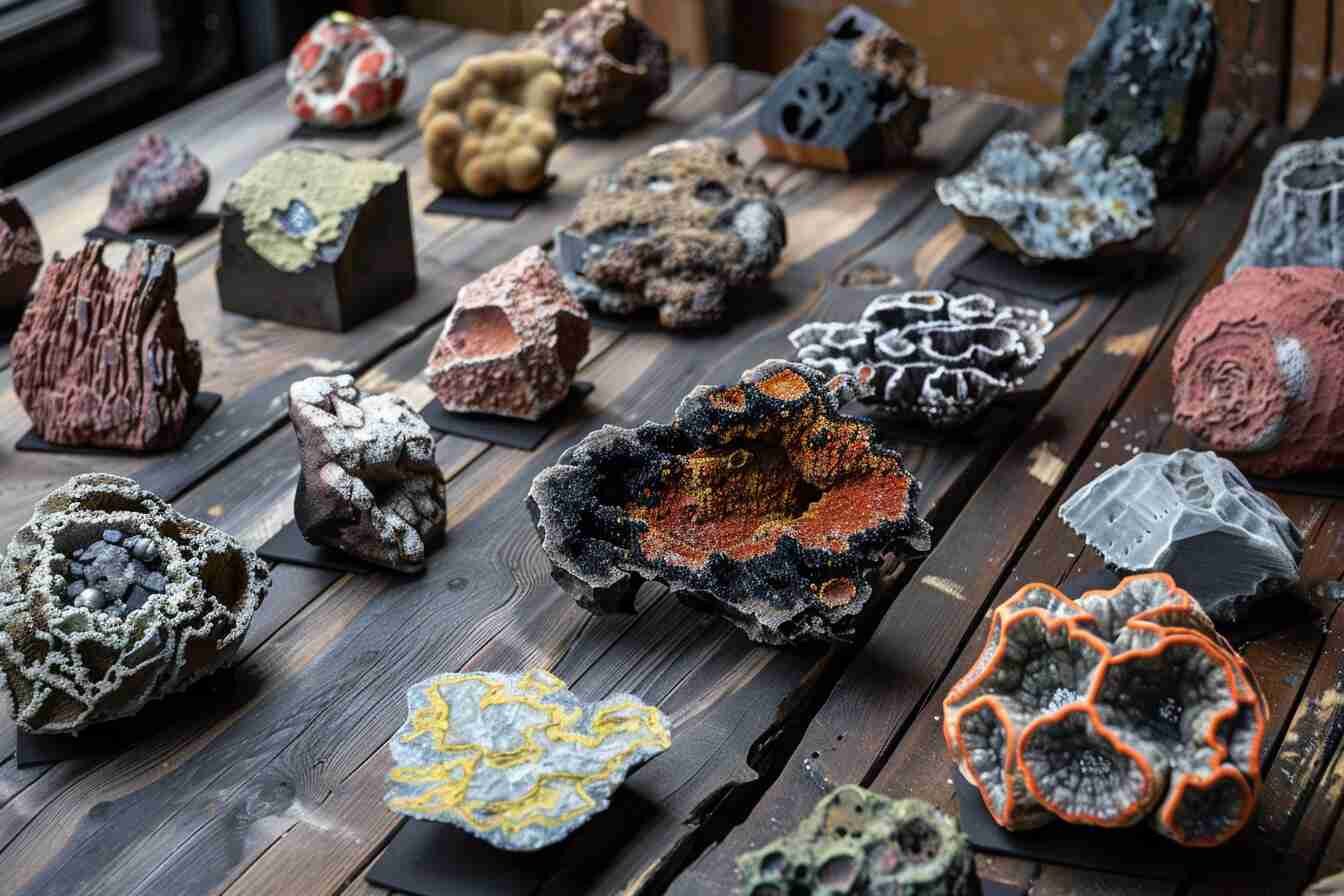Different kinds of meteorites: chondrites, siderites, pallasites…
Meteorites are rocks of extraterrestrial origin and there are different kinds of meteorites. They can be very small or weigh several tons. They differ among themselves in their nature, depending on their place of formation. Some come from the Moon, others come from Mars, or from asteroids, even comets or extinct planetoids. All have a fascinating story to tell.
There are different kinds of meteoritesmeteorites. Here we look at siderites, pallasites and lithoids (including chondrites).
Classical classification for different kinds of meteorites
Meteorites have traditionally been divided into three broad categories: rocky (also called aeroliths), mainly composed of silicates ; ferrous (also called siderites), mostly composed of an alloy of iron and nickel; and iron-rock (also called siderolites), which contain both metal and rock in similar proportions.
The classification of meteorites is based primarily on observed characteristics. Just because some of them belong to the same category, it does not necessarily follow that they all consist of meteorites that have the same or similar parent bodies. In fact, more often than not, they are unrelated. On the other hand, it is possible that meteorites of different categories have a common origin.
The classical subdivision of ferrous meteorites was of a structural type. Here is the main classic pattern:
1. Rocky Meteorites or Aeroliths
- Chondriti
- Achondrites
2. Ferrous Meteorites or Siderites
- Ataxites
- Octahedrites
- Hexahedrites
3. Stony-iron meteorites or Siderolites
- Pallasites
- Mesosiderites
Siderites (iron meteorite) and the shape of Widmanstätten
Siderites are a family of meteorites that are not very abundant, less than 6% of the sample. However, to those who know how to recognize and treat them, they offer a class that is equaled only by the pallasites.
With a dark exterior appearance, like many stones, siderite does not seem to be of any interest. Very heavy and sensitive to magnetizationmagnetization, a specialist will however recognize it immediately in a lot of amorphous amorphous rocks.
These siderites were formed in the distant past, in the core of a still-melting parent star which differentiated iron from less dense silicates and then cooled. Iron and nickel then crystallized to give the Widmanstätten pattern, one of the many possible arrangements of molten metalmetal.
A word of advice if you buy them: pay attention to their conservation. These meteorites are made of iron. However, they are often left out in the open in a display case or on a shelf. If so, the iron will oxidize within a few years and your beautiful siderite will begin to rust. Take advice from a museum or a chemical laboratory so that they can provide you with an antioxidantantioxidant with which you can coat the polished part and thus prevent premature aging.

The Willamette Meteorite is an iron-nickel meteorite, found in the U.S. state of Oregon. Displayed at the American Museum of Natural History in New York City. It weighs about 14,500 kilograms (32,000 pounds). This is the largest meteorite ever found in the United States. User:Dante Alighieri, CC BY-SA 3.0, via Wikimedia Commons
Pallasites and their olivine crystals
Pallasites, from the mesosiderite family, contain iron and silicate inclusions, especially olivine which gives them a very colorful appearance. They are highly coveted and have a significant market value.

A stony-iron pallasite Springwater’s slab, weight 3,9 gram, measurements 37,9 х 28,6 х 1,6 mm. Meteorite was found near Springwater, Saskatchewan in 1931.
Pallasite stony-iron meteorite containing a mixture of olivine crystals and nickel-iron metal in approximately equal amounts. Pallasites are one of the rarest types of iron-rich meteorites.
The olivine in pallasites is the same mineral as the gemstone Peridot but these peridot are special they are not from the Earth. OksanaStich, CC BY 4.0, via Wikimedia Commons
Lithoids, non-ferrous meteorites
The lithoids are a family that includes non-ferrous meteorites; it is the largest with nearly 93% of all known specimens. The lithoids include:
- achondritesachondrites, whose crustcrust is smooth;
- carbonaceous chondrites, which can be recognized by their blistered crust.
However, it is the microscopic or chemical analysis that is often decisive.
The lithoids do not contain iron or nickel. They are much more fragile than siderites and can disintegrate on contact with the ground. Made up of differentiated or totally reprocessed matter, they are formed by fusion then recrystallization-recrystallization in the core or on the surface of a parent star. This results in a distinct structure and mineralogy typical of an igneous process.
Achondrites mainly contain siliconsilicon and silicates such as magnesiummagnesium oxide. There are also traces of chlorchlorine, potassiumpotassium, scandiumscandium, titaniumtitanium, vanadiumvanadium, manganese, etc. The presence of enstatite gives them a white internal color.

77g Achondrite eucrite Millbillillie, a monomictic breccia results from rock deformation by shearing and granulation (cataclasis) in the process of tectonism or – more general – dislocation metamorphism. If the dislocation metamorphism is impact-related, the produced cataclasite may be termed a monomict impact breccia. Dr. Svend Buhl, Niger Meteorite Recon, CC BY 3.0, via Wikimedia Commons
Chondrites: carbonaceous, ordinary and enstatite
Isotope dating gives the chondrites an age of 4.55 billion years. This is the approximate age of the Solar System. They are therefore the rare virginal representatives of the raw material which fashioned the Solar SystemSolar System (even if, as we shall see, in many cases their native properties have been altered by heat or cold). Their study is therefore particularly interesting for determining the primitive composition of the Solar System.
This type of meteorites is composed of 15 to 75% of chondreschondres (from the Latin chondros which means “grain of sand”), kinds of small clear inclusions composed of olivine and pyroxene in different proportions and structures.

Cut Chondrite meteorite, part of its bark is visible on the surface. Tiia Monto, CC BY-SA 3.0, via Wikimedia Commons
By their properties and their particular granular structure, chondrites give us a precise clue as to their origins. Researchers have divided them into three main families:
- Carbonaceous.
- The ordinary.
- Enstatites.
Ordinary chondrites, the most common, contain both volatile elements (gasgas) and oxidized elements (iron, magnesium, etc.) which have undergone rapid crystallization, sometimes in liquid-liquid form. Their spherical shape also suggests very low or no gravity. These processes suggest that they stayed inside the asteroid belt and evolved in an environment apart from planets, far from gravitational constraints.
Enstatite chondrites have abundant refractory refractory elements, a sign of high temperatures. They have been completely reduced. They would therefore come from the inner region of the Solar System.
Read also: Nasa DART Mission | First time crashed into an asteroid to change its trajectory
As for the carbonaceous chondrites, they present the most volatile elements and are also the most oxidized rocks. They would have been formed at greater distances from the Sun.
Each category of chondrite is then subdivided into subgroups to distinguish certain structures typical of their evolution.

Saint-Sauveur (Haute-Garonne) France an enstatite meteorite, Chondrite group EH5, 14Kg. Fell in 1914. Muséum de Toulouse, CC BY-SA 4.0, via Wikimedia Commons
Carbonaceous chondrites are subdivided into three main categories according to their organic matter content:
- type C1 contains sulphates, iron magnetitemagnetite, nickel and silicates in amorphous hydrated form. Their granular structure proves that the material agglomerated at low temperature, below 500°C. These meteorites contain up to 6% organic compounds (carboncarbon);
- type C2 contains sulfur and iron in hydrated form. These meteorites contain chondrules, small inclusions about 1 cm in diameter. They contain 2.5% carbon;
- type C3 is less hydrated than type C2 chondrites and contains much less carbon (0.5%).
Finally, the carbonaceous chondrites are divided into various petrographic groups:
CI: Ivuna.
CK: Karoonda.
CM: Mighei.
CO: Ornans.
CR: Renazzo.
CV: Vigarano.
Nasa DART Mission | First time crashed into an asteroid to change its trajectory
Sources: PinterPandai, The Natural History Museum – London, National Geographic, Britannica
Photo powered by Midjourney
Solar System a World Full of Surprises | Composition, Formation and Evolution



